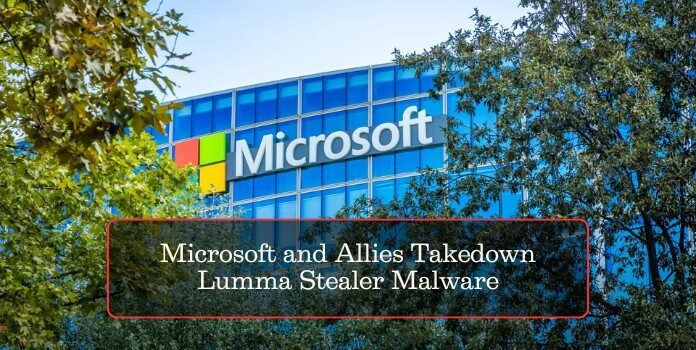
Microsoft and Allies Takedown Lumma Stealer Malware
June 25, 2025 — In a landmark victory for cybersecurity, Microsoft has announced the takedown of the notorious Lumma Stealer malware network. This coordinated effort, led by Microsoft’s Digital Crimes Unit (DCU) and supported by a consortium of international law enforcement bodies, resulted in the seizure of over 2,300 malicious domains and a major blow to a malware campaign that infected nearly 400,000 Windows systems globally.
What Is Lumma Stealer?
Lumma Stealer, also known as “LummaC2”, is a type of infostealer malware—a malicious program specifically designed to extract sensitive user data like passwords, browser cookies, cryptocurrency wallets, and session tokens from infected devices. First observed in 2022, the malware has evolved into a major tool for cybercriminals, often sold as Malware-as-a-Service (MaaS) on darknet forums.
How It Works:
- Delivered through phishing emails, malicious ads, or bundled with pirated software
- Once installed, it quietly harvests data and sends it to a command-and-control server
- Frequently updated by its developers to avoid detection by antivirus programs
According to Microsoft, Lumma Stealer’s infrastructure relied heavily on compromised domains and fast-flux hosting, which helped it stay resilient and evasive.
Microsoft’s Role in the Operation
Microsoft’s Digital Crimes Unit, which specializes in disrupting cybercrime operations, spearheaded the investigation with assistance from threat intelligence teams. Their multi-pronged approach included:
- Tracking and mapping the command-and-control infrastructure
- Identifying domain registrars and cloud services used by the malware operators
- Coordinating with law enforcement agencies across multiple countries
- Filing legal motions to disable the infrastructure in cooperation with U.S. courts
Brad Smith, Vice Chair and President of Microsoft, stated:
“This takedown demonstrates what can be achieved when tech companies, governments, and law enforcement agencies come together. It sends a strong message that cybercriminals can and will be stopped.”
Global Law Enforcement Joins the Fight
This wasn’t just Microsoft acting alone. Law enforcement agencies from the United States, Europe, Asia, and South America played crucial roles in executing search warrants, collecting evidence, and seizing domains.
The operation involved:
- INTERPOL and Europol’s Cybercrime Centre
- The FBI Cyber Division
- National Cybersecurity Agencies from at least seven countries
Officials say the coordinated seizures disrupted communication channels used by Lumma Stealer’s operators, effectively crippling the malware’s reach.
2,300 Domains Seized – Here’s Why It Matters
These domains were primarily used as:
- Command-and-control centers for stolen data
- Redirection platforms for phishing pages
- Malware distribution channels
By taking them offline, the coalition not only halted ongoing infections but also prevented further data exfiltration attempts.
Microsoft’s report notes: “Each domain represented a potential threat to thousands of users. Seizing them significantly reduces the malware’s distribution capabilities.”
A Wake-Up Call for Cybercriminals
Cybersecurity experts believe this takedown is a strategic win in a long-standing war against malware-as-a-service operations. Lumma Stealer had become one of the most notorious infostealers in the market, and this operation might lead to further arrests and indictments.
Alex Weinert, Microsoft’s VP of Identity Security, commented:
“These malware networks thrive on anonymity and scale. Disrupting their infrastructure limits their ability to operate in the shadows.”
What Should Users Do Now?
Although Lumma Stealer’s infrastructure has been crippled, threats remain. Microsoft and cybersecurity experts recommend the following steps:
User Safety Tips:
- Run a full antivirus scan using updated security software
- Reset passwords for all accounts, especially banking and email
- Enable multi-factor authentication (MFA) wherever possible
- Avoid downloading software from unverified or pirated sources
- Stay alert to suspicious emails or pop-up ads
For organizations, Microsoft suggests using Microsoft Defender for Endpoint, reviewing internal logs, and training employees on phishing awareness.
Bigger Picture: Collaboration is Key
This operation highlights a growing trend: collaborative cybersecurity, where private tech giants work hand-in-hand with international authorities to fight cybercrime.
“We’re entering a new era where coordinated takedowns become standard practice,” said Jen Easterly, Director of the U.S. Cybersecurity and Infrastructure Security Agency (CISA). “It’s no longer enough to react—we need to be proactive, strategic, and unified.”
What’s Next?
Microsoft has confirmed that investigations into the creators and distributors of Lumma Stealer are ongoing. Legal teams are also working to ensure the domains remain offline and can’t be repurposed.
Meanwhile, cybercriminals may attempt to regroup or launch variants under different names—a common tactic in the malware ecosystem. But experts believe this takedown will significantly disrupt their timeline and force them to reconsider the risks.











